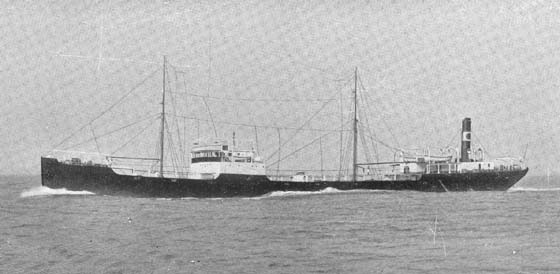
The Compagnie Generale des Tabacs des Phillipines (General Tobacco Company of the Phillipines) had branched out into a number of secondary commercial ventures, including snuff, sugar and copra. Processing of the copra produced oil which the company shipped to various overseas markets, particularly Europe, but eventually to be dominated by the US market. Prior to World War I the annual volume exported varied between 20,000 to 30,000 tons. Production remained strong during World War I leading to the creation of the Hispanic Philippine Oil Co to produce the oil, a new factory would be established at San Marcelino and the creation of Eastern Trade Company to handle the oil shipments in newly built tankers.
The copra industry, like many others of the period entered a time of crisis which led to the failure of the Hispanic Philippine Oil Company in 1922 and the closure of the plant at San Marcelino in 1928.
At least two vessels were ordered by the company for the copra oil trade:
1/ The steam powered, steel hulled 7,890 ton Elcano which was built in England in 1918. It was 400 feet long, 52 feet wide and 28 feet draught.
2/ The diesel powered Conde de Churruca.
The ship, the first large British ship equipped with Sulzer Diesel machinery, was ordered from Sir WG Armstrong, Whitworth & Co., Limited, at its shipyard at Newcastle. It was equipped with seven double walled tanks to hold the oil cargo. These tanks, along with those carrying the oil supply for the diesel engine were heated by coils containing steam supplied by a donkey boiler situated in the engine room. This boiler also provided steam for the deck machinery, windlass, three winches and cargo pumps. The boiler was 10 feet 6 inches in diameter and 11 feet 6 inches tall, with two burners to burn fuel oil to natural draft.
The main steering gear unit, the Hele-Shaw brand Martineau, hydroelectric type, supplied by John Hastie & Co, Ltd, was mounted on the stern on the upper deck, directly connected to the head of the rudder. The ship's lighting was all electric, supplied either by the main generators when at sea or from the port auxiliary sets.
The two four cylinder S60 type engines had been built in 1917 and placed into stock before being purchased by Armstrong Whitworth in 1919 for use in the Conde de Churruca. This order is significant in that it was the first use of large Sulzer engines after World War I, as shipping companies made good the losses from the conflict and otherwise updated their fleets. Normal rating for the engines was 2,500 bhp continuous at 100 rpm. The engines went through extensive testing, running on gas oil, Mexican oil and tar oil mazout. Any of these fuel oils could be burned without alteration of the engine settings or the machine load. The Mexican crude contained up to 15% asphalt. In the rear of the engine room were two electric generators connected to a dynamo. Each generator provided 70 kW at 220 volts.
During August 1921 the Conde de Churruca successfully completed its acceptance trials, exceeding in many cases the specifications laid down when ordered. The ship was immediately hired by the UK (?) Government to supply water to the army in North Africa, departing on September 12th 1921, proceeding from Newcastle to Southampton and on to Melilla (a Spanish Protectorate on the Mediterranean coast of Morocco) with a cargo of 6,500 tons of fresh water, then returning to Newcastle.
Excessive vibrations were noted when running the engines at 95rpm due to problems with the bearing seats and the propellor shafts. This problem was quickly resolved and on February 12th 1922 the ship resumed service, leaving for London, Hamburg and Bilbao. Following this the ship's engines provided trouble free operationon, daily fuel consumption was on average 8.9 tons of crude oil, whilst daily lubricating oil consumption was 45 liters - these numbers included both the main engines and auxiliary machinery of the ship.
Because of worsening financial condition of the ships owners, the ships were sold in 1927 to the newly created CAMPSA.
The ship was renamed Remedios, and it is reported that at some point its engines were changed.
The fate of the ship.........?
Details
Built: W G Armstrong Whitworth Co Ltd, Newcastle 1921
Launched: August 1921
Tons: 4,550 tons gross; 6,500dwt
Length: 370ft
Breadth: 48ft 7in
Draught: 30ft
Propulsion: 2 x 4-cylinder Sulzer Winterthur 4S60 diesel engines of 1,700hp each
Auxiliary engines: 2 x 4SS20 (total 200hp at 325rpm) and 2 x MC12 (total 12hp at 450rpm).
Screws: 2
Speed: 11.5 knots
Crew: ??
Home port: ??
Resources:
Sulzer: List of Motorships
The Shipbuilder Monthly Vol XXV No 135 November 1921
Pacific Marine Review Vol 18 Oct 1921
Engineer Vol 132 No.3429 Sept 16th 1921, pp297-301
Page added October 11th 2010.
Return to Ship menu
Return to site menu